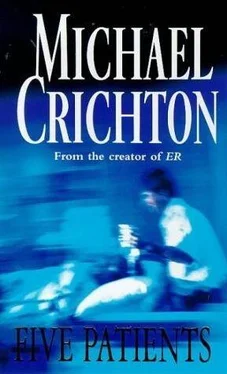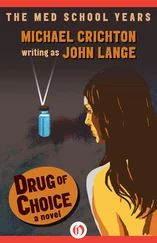Michael Crichton - Five Patients
Здесь есть возможность читать онлайн «Michael Crichton - Five Patients» весь текст электронной книги совершенно бесплатно (целиком полную версию без сокращений). В некоторых случаях можно слушать аудио, скачать через торрент в формате fb2 и присутствует краткое содержание. Жанр: Триллер, на английском языке. Описание произведения, (предисловие) а так же отзывы посетителей доступны на портале библиотеки ЛибКат.
- Название:Five Patients
- Автор:
- Жанр:
- Год:неизвестен
- ISBN:нет данных
- Рейтинг книги:5 / 5. Голосов: 1
-
Избранное:Добавить в избранное
- Отзывы:
-
Ваша оценка:
- 100
- 1
- 2
- 3
- 4
- 5
Five Patients: краткое содержание, описание и аннотация
Предлагаем к чтению аннотацию, описание, краткое содержание или предисловие (зависит от того, что написал сам автор книги «Five Patients»). Если вы не нашли необходимую информацию о книге — напишите в комментариях, мы постараемся отыскать её.
Five Patients — читать онлайн бесплатно полную книгу (весь текст) целиком
Ниже представлен текст книги, разбитый по страницам. Система сохранения места последней прочитанной страницы, позволяет с удобством читать онлайн бесплатно книгу «Five Patients», без необходимости каждый раз заново искать на чём Вы остановились. Поставьте закладку, и сможете в любой момент перейти на страницу, на которой закончили чтение.
Интервал:
Закладка:
Similarly, water, which normally accounts for 70 per cent of body weight, is carefully distributed in a healthy person-so much inside cells, so much outside cells. Individual water molecules are constantly shifting around the body, but the balance in each compartment is closely maintained. Edema, the pathological swelling of certain tissues with water, can be caused by a wide range of factors that disrupt the normal distribution of body water. The same effect can be produced by heart disease, liver disease, or kidney disease, each by a different mechanism.
Mrs. Murphy was admitted to the Bulfinch medical wards and passed an uneventful night. In the morning she was seen on work rounds by Carey, Nienhuis, and another resident, Dr. Robert Liss. Practical aspects of her condition were discussed, particularly the question of transfusion. It was decided to postpone transfusion since she appeared comfortable for the moment. Later in the day Mrs. Murphy's problems were discussed with the visiting senior physician on the wards, Dr. John Mills. He felt that "tumor in the abdomen was strongly indicated," but for a variety of reasons felt that lymphoma, a cancer of lymph glands, was more likely than pancreatic cancer.
That same day, a radioactive liver scan was done to determine the size of the liver, since it could not be felt directly. The liver was found to be small and shrunken, suggestive of scarring from cirrhosis. The basis for this cirrhosis was unclear. Mrs. Murphy maintained that she was a non-drinker. She had no history of hepatitis in the past, and no occupational exposure to liver poisons. The cirrhosis was therefore labeled "cryptogenic," meaning of hidden cause.
For the next three days the question of cancer, or liver disease, or both, was widely discussed. As evidence of liver damage accumulated, cryptogenic [To an outsider, the tendency among physicians to call certain diseases cryptogenic or idiopathic-and then to discuss them as if they were well-defined, understood clinical entities-may be perplexing. But in fact it serves a purpose. For one thing, it excludes diagnoses: anyone who speaks of cryptogenic cirrhosis has excluded alcoholic or post-hepatitic cirrhosis. By implication, the term conveys more information than a simple "We don't know why." In the same way, idiopathic hypertension implies prior exclusion of the few known causes of this condition] cirrhosis became the favored diagnostic possibility.
Meanwhile, Mrs. Murphy began to feel better. She received a transfusion of three units of blood, and felt better still. She did not, however, receive any further therapy.
Everyone agreed that a liver biopsy would be useful, but the patient had a bleeding tendency- presumably secondary to liver disease-which made a biopsy impossible. Other diagnostic procedures were not helpful. Sigmoidoscopy and barium enema failed to determine the origin of gastrointestinal bleeding. A check for cancer cells in her abdominal fluid was negative.
On the seventh hospital day, she was seen by Dr. Alexander Leaf, who suggested thyroid tests as well as tests for collagen diseases. The following day, Dr. Nienhuis raised the question of whether this patient might have lupoid hepatitis, a rare and somewhat disputed clinical entity.
In the next forty-eight hours, two important pieces of evidence were obtained. First, an upper GI series was done, and it was normal. There was no sign of cancer of the pancreas.
Second, a re-examination of the patient's white cells revealed several with large, abnormal, bluish lumps imbedded within the cell substance. These cells are called LE cells, for they are virtually diagnostic of a collagen disease, systemic lupus erythematosus.
This is a disease of enormous interest to physicians at the present time. Once considered rare, it is now seen with increasing frequency as diagnostic tests become more refined. Classically it has been considered a disease of middle-aged women, characterized by protein manifestations-fever, skin eruptions, and involvement of many other organs, particularly joints and kidneys. However, as lupus is better understood, the classical description is changing: more males are now found with SLE, and the range of clinical manifestations has broadened.
Lupus is called a collagen disease because it shares with certain other diseases a tendency to alter blood vessels and connective tissue, and because it seems, like these other diseases, to be caused by some form of hypersensitivity (allergy). This question of causation is by no means clear, but patients with the disease certainly show a wide variety of biochemical disorders of the immune system; lupus is frequently called "the autoimmune disease par excellence."
Normally, the body's immune mechanism produces antibodies to fight agents, such as invading bacteria. This response is generally beneficial to the individual, although much recent work has gone into suppressing the response so that foreign organs can be transplanted.
However, it is now recognized that the body's natural rejection mechanism can sometimes be mistakenly directed toward the body itself. In some way the individual's capacity to distinguish what is native from what is foreign is disrupted; the patient attempts to produce immunity to himself-and proceeds to attack certain of his own tissues, leading to "a chronic civil war within the body."
In the case of lupus, the patient produces several sorts of antibodies against himself. One of these attacks DNA, the genetic substance of chromosomes. This damaged DNA is later ingested by white cells, producing the characteristic bluish lumps. However, SLE patients also produce other auto-antibodies, which are seen in other conditions. Thus Mrs. Murphy was found to have anti-DNA antibodies, increased gamma globulin, and antibodies against thyroid, as well as antibodies found in rheumatoid arthritis.
Immune disorders as a cause or complication of illness are now suspected for a great range of diseases, including rheumatic fever, pernicious anemia, myasthenia gravis, multiple sclerosis, Hashimoto's thryoiditis, and glomerulonephritis. Immune and auto-immune mechanisms are thus of considerable interest; investigation of these mechanisms represents one of the major thrusts of current medical research.
For systemic lupus erythematosus, however, there is no cure and no good information on prognosis. Patients have died within a few months of onset; others have lived fifteen or twenty years. For Mrs. Murphy, therapy consisted of diuretics, which resulted in loss of thirty-two pounds of fluid, and a cautious trial of corticosteroids to suppress some effects of the disease. She was discharged feeling well and returned to her job.
The case of Mrs. Murphy illustrates an important function of the ward patient in the university hospital that differentiates him from the private patient: the ward patient is there in part to help turn students into doctors. For the patient, this has its drawbacks as well as its advantages.
First, to clarify some terms:
A medical student is anyone with a bachelor's degree who is in the midst of four years of graduate work leading to the M.D. degree, but not yet to a license to practice. To be licensed, he must spend an additional year as an intern in a teaching hospital.
An intern is thus anyone with an M.D. who is in his first year out of medical school. An intern is licensed to practice only within the hospital. After a year of internship, he could theoretically leave and begin private practice, but practically nobody does. Instead, interns go on to become residents.
A resident is anyone who has finished his internship and is continuing with more specialized training in such areas as pediatrics, surgery, internal medicine, or psychiatry. A residency may be taken at the same hospital as the internship or at another; residencies last from two to six years, depending on the field.
Читать дальшеИнтервал:
Закладка:
Похожие книги на «Five Patients»
Представляем Вашему вниманию похожие книги на «Five Patients» списком для выбора. Мы отобрали схожую по названию и смыслу литературу в надежде предоставить читателям больше вариантов отыскать новые, интересные, ещё непрочитанные произведения.
Обсуждение, отзывы о книге «Five Patients» и просто собственные мнения читателей. Оставьте ваши комментарии, напишите, что Вы думаете о произведении, его смысле или главных героях. Укажите что конкретно понравилось, а что нет, и почему Вы так считаете.









